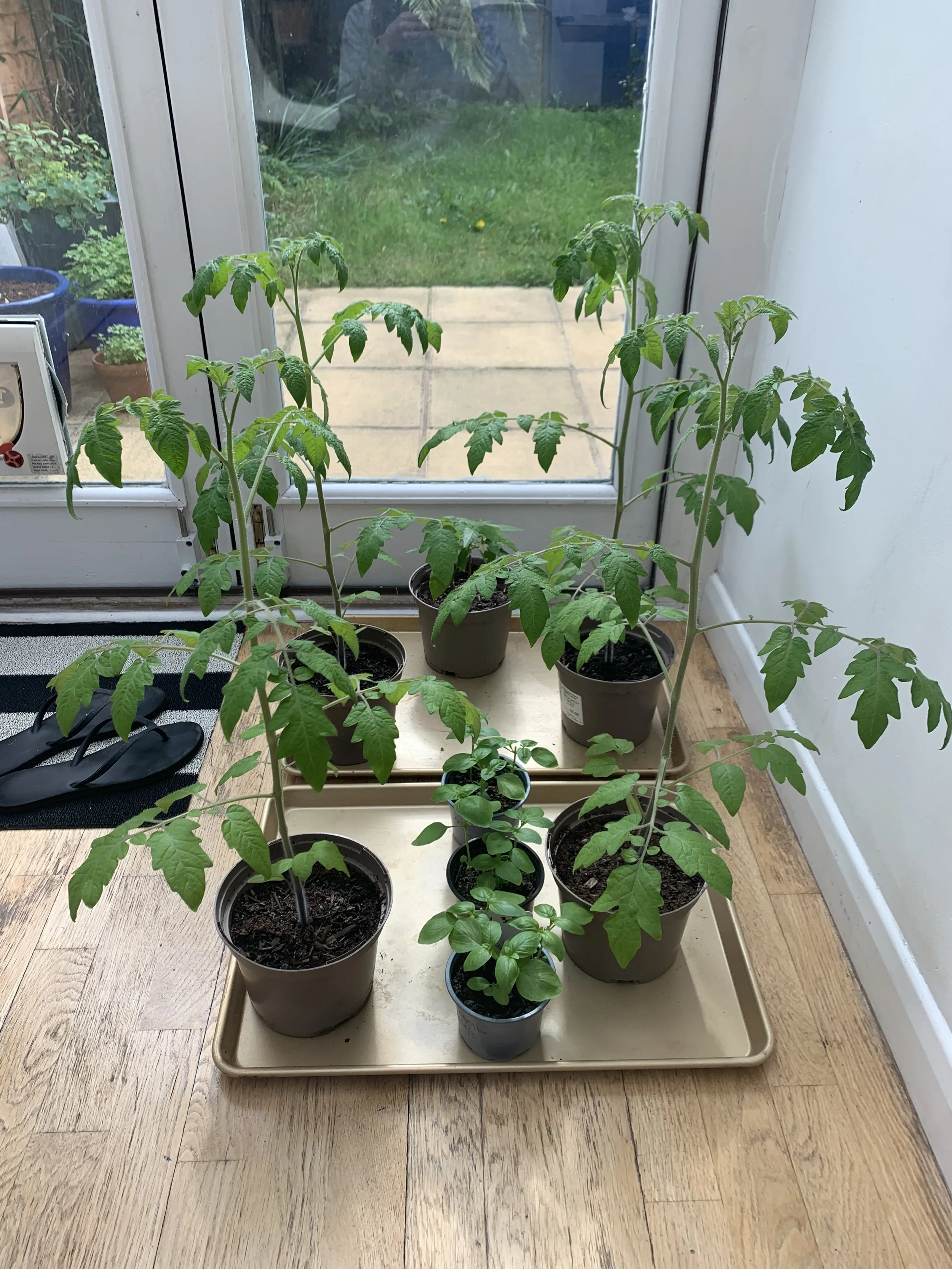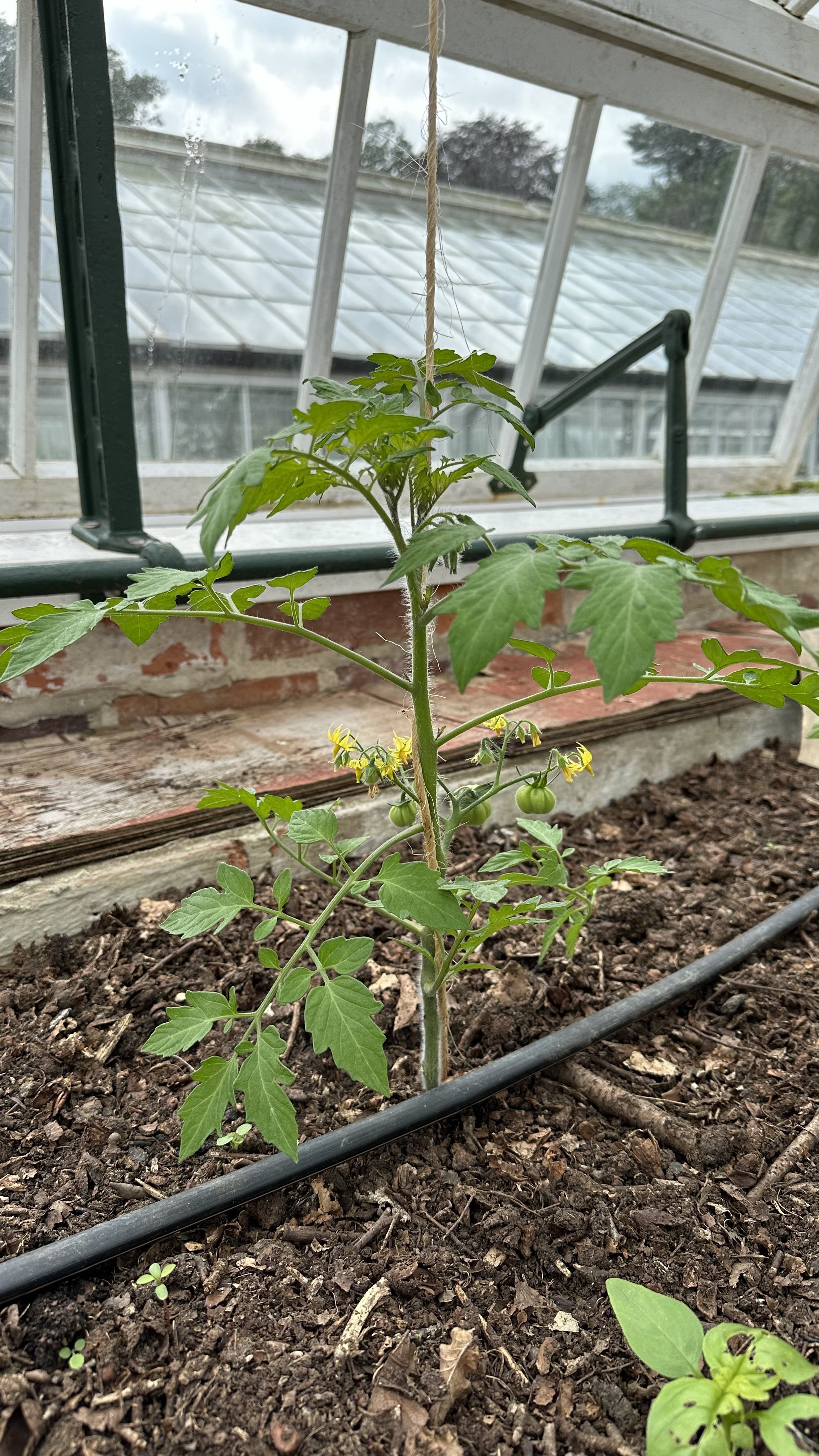Leggy Tomato Seedlings: Causes and Solutions
This website is reader-supported - thank you! This post may contain affiliate links. As an Amazon Associate, I earn from qualifying purchases at no extra cost to you.
Growing tomatoes is really exciting and rewarding, but it can be frustrating when your seedlings start to grow tall and spindly instead of strong and sturdy.
This phenomenon, known as leggy tomato seedlings, is a common problem, especially those who start their seeds indoors.
Here we'll explore the causes of leggy tomato seedlings and provide tips on how to prevent this problem from happening in the first place.
We'll also discuss how to save leggy tomato seedlings and help them become healthy, productive plants.
To learn more about growing tomatoes, check out my guides:
Quick Homemade Tomato Fertilizer
What are leggy tomato seedlings?
Leggy tomato seedlings are tomato plants that have grown tall and spindly, with long, thin stems and small, pale leaves.
This phenomenon occurs when tomato seedlings don't receive enough light or when they are grown in warm, crowded, or overly moist conditions.
Leggy tomato seedlings are weaker and more susceptible to pests and diseases, and they may not be as productive as healthy, sturdy plants.
To prevent leggy tomato seedlings, it's important to provide them with sufficient light, avoid overcrowding, plant them at the proper soil depth, and water them consistently.
If leggy tomato seedlings do occur, they can often be saved by transplanting them into deeper soil, burying the stem, or providing additional light or support.
To learn more about growing from seed, check out my guide:
Why is legginess a problem?
Weakness
Leggy tomato seedlings tend to have thin, weak stems that are more susceptible to bending or breaking.
This can make it difficult to transplant the seedlings without damaging them.
Susceptibility to Pests and Diseases
Leggy tomato seedlings are often more susceptible to pests and diseases.
This is because they are weaker and less able to defend themselves against attacks.
Reduced Productivity
Leggy tomato plants may not be as productive as healthy, sturdy plants.
This is because they may not be able to support as much fruit or may be more prone to stress, which can affect fruit production.
Difficulty in Transplanting
When it's time to transplant your leggy tomato seedlings into the garden, their weak stems can make it difficult to move them without damaging the plant.
Overall Health
Leggy tomato plants tend to be less healthy overall, which can impact their growth and development throughout the growing season.
To learn more about growing tomatoes, check out my guides:
The Art of Harvesting Tomatoes: When and How to Pick the Perfect Fruit
Can leggy tomato seedlings be saved?
Yes, leggy tomato seedlings can be saved.
However, it is important to act quickly to prevent the problem from getting worse.
Here is how to fix leggy seedlings:
Bury the Stem
Gently bury the leggy stem of the tomato seedling up to the first set of true leaves.
This will encourage the plant to grow new roots from the buried part of the stem, and the buried part will eventually become a strong part of the stem.
Use Support
If the tomato seedling is too tall and floppy, use a support like a stake or a bamboo pole to keep it upright.
You can gently tie the stem to the support using a soft, flexible material like twine or cloth.
Prune
If the tomato seedling has grown too tall and spindly, you can prune it back to just above the first set of true leaves.
This will encourage the plant to grow new shoots and become bushier.
Provide Adequate Light
Make sure the tomato seedling is getting enough light.
If it's indoors, provide artificial light using fluorescent or LED grow lights.
Make sure to keep the lights about 2 inches above the seedlings.
Here are the grow lights I recommend for growing tomato seedlings indoors:
Adequate Watering
Water the tomato seedlings properly, and make sure the soil is moist but not waterlogged.
Overwatering can lead to root rot, which can further weaken the plant.
For more watering tips, check out my guide How Often to Water Seedlings.
It's important to remember that leggy tomato seedlings are a sign of stress, and it's best to prevent the problem from happening in the first place.
However, if you find yourself with leggy tomato seedlings, don't panic.
With proper care and attention, you can save your tomato seedlings and help them grow into healthy, productive plants.
To learn more about growing tomatoes, check out my guides:
The Best Companion Plants for Tomatoes
Will leggy tomato seedlings survive?
Leggy and spindly tomato seedlings have a higher risk of being weaker and more susceptible to pests and diseases, but with proper care, they can survive and even thrive.
However, it's important to act quickly and address the issue as soon as possible to prevent it from getting worse.
By burying the stem, using support, pruning, providing adequate light, and proper watering, you can help your leggy tomato seedlings recover and become healthy plants.
It's important to remember that tomato seedlings need sufficient light to develop strong stems and leaves, so providing adequate light is crucial.
In addition, if you are starting your tomato seeds indoors, it's best to sow them at the right depth and provide sufficient light from the beginning to prevent leggy seedlings from developing in the first place.
Overall, while leggy tomato seedlings may face some challenges, they can survive and thrive with proper care and attention.
Will leggy tomato plants produce fruit?
Leggy tomato plants have the potential to produce fruit, but they may not be as productive as healthy, sturdy tomato plants.
This is because leggy tomato plants tend to be weaker and more susceptible to pests and diseases, which can affect their growth and fruit production.
However, with proper care and attention, you can help your leggy tomato plants become stronger and more productive.
Pruning the plant to encourage bushier growth and providing sufficient light, water, and nutrients can help improve the plant's health and increase its fruit production.
It's also important to note that some tomato varieties are more tolerant of legginess than others.
Determinate varieties, for example, tend to have a more compact growth habit and may be less affected by legginess than indeterminate varieties.
Overall, while leggy tomato plants may not be as productive as healthy plants, they still have the potential to produce fruit.
With proper care, you can help your leggy tomato plants become healthier and more productive, and enjoy a bountiful harvest of fresh, delicious tomatoes.
What causes leggy seedlings?
There are several factors that can contribute to the development of leggy tomato seedlings:
Insufficient Light
One of the primary causes of leggy tomato seedlings is a lack of sufficient light.
When tomato seedlings don't receive enough light, they'll stretch their stems to try and reach the light source.
This can cause the seedlings to become tall and spindly, with weak, thin stems.
High Temperature
Another factor that can contribute to leggy tomato seedlings is high temperatures.
When tomato seeds are germinated in warm conditions, the seedlings will grow more quickly, but they may also become leggy and weak.
Overcrowding
When tomato seedlings are planted too close together, they'll compete for resources, including light.
This can cause them to stretch their stems and become leggy in an attempt to reach the light.
Improper Soil Depth
If tomato seeds are planted too deep in the soil, the seedlings may have to stretch their stems to reach the surface.
This can cause them to become leggy and weak.
Inadequate Watering
Tomato seedlings need consistent moisture to grow strong and healthy.
If they don't receive enough water, they may become stressed and leggy as they try to conserve resources.
To learn more about growing from seed, check out my guide:
How to Prevent Leggy Tomato Seedlings
Provide Adequate Light
Tomato seedlings need 14-16 hours of light each day.
If you don't have enough natural light, you can use fluorescent lights or other grow lights to supplement.
Keep the lights about 2 inches above the seedlings.
Maintain Proper Temperature
Tomato seedlings prefer temperatures between 65-75 degrees Fahrenheit.
Make sure to keep them away from heat sources such as radiators or direct sunlight.
Use Good Quality Seed-Starting Mix
Use a seed-starting mix that contains coconut coir and perlite (avoid any compost with peat moss).
These ingredients help to maintain proper moisture levels and provide the necessary nutrients for healthy growth.
Here is the seed-starting mix I recommend for tomatoes:
Water Properly
Water your tomato seedlings only when the top layer of soil feels dry.
Overwatering can lead to root rot and affect the growth of your tomato plants.
Transplanting Leggy Seedlings
Transplanting leggy seedlings can help to address the issue of legginess by burying the thin, spindly stems and encouraging the development of a stronger root system.
Here's how to plant leggy tomatoes:
Prepare the New Container
Choose a container that is at least 4-6 inches deep and wide enough to accommodate the root system of the seedling.
Fill the container with fresh potting soil, leaving enough room at the top for the seedling.
Dig a Hole
Using a small trowel or your fingers, dig a hole in the center of the potting soil deep enough to bury the stem of the leggy seedling.
Remove the Seedling
Gently remove the leggy seedling from its current container, being careful not to damage the stem or roots.
Bury the Stem
Place the seedling in the hole you dug, burying the stem up to the first set of true leaves.
The true leaves are the first set of leaves that grow after the seedling's cotyledons (the seed leaves).
Firm the Soil
Gently firm the soil around the seedling, making sure it is stable and not tilting to one side.
Water Thoroughly
Water the seedling thoroughly, being careful not to wash away the soil or disturb the roots.
Provide Proper Light
Place the newly transplanted seedling in a location with plenty of bright, indirect light or under grow lights.
It's important to be gentle when transplanting tomato seedlings leggy, as they may be more fragile than healthy, sturdy seedlings.
With proper care and attention, transplanted leggy seedlings can often recover and grow into healthy, productive tomato plants.
Care Tips for Tomatoes
Here are my top care tips for growing healthy and productive tomato plants:
Plant in the Right Location
Tomatoes require full sun (at least 6-8 hours per day) and well-drained soil with plenty of organic matter.
Choose a location in your garden that receives full sun and has well-drained soil.
A south facing or west facing garden spot is best.
Water Consistently
Tomatoes need consistent moisture to thrive, but they don't like to be overwatered.
Water deeply and consistently, but allow the soil to dry out slightly between waterings.
Fertilize Regularly
Tomatoes are heavy feeders and require regular fertilization to grow strong and produce fruit.
Use a balanced fertilizer or compost tea every 2-3 weeks throughout the growing season.
Here is the fertilizer I recommend for tomatoes:
Prune and Stake
Tomatoes benefit from pruning and staking, which helps to keep them upright and promotes good air circulation around the plants.
Prune off any suckers (the small shoots that grow in the crotch between the stem and branches), and use a tomato cage to support the plants.
Here is the tomato cage I recommend for growing tomatoes:
Monitor for Pests and Diseases
Tomatoes are susceptible to a variety of pests and diseases, so it's important to monitor your plants regularly and take action if you notice any issues.
Use organic pest control methods whenever possible, and consider using disease-resistant tomato varieties.
Harvest Regularly
Tomatoes should be harvested regularly, as leaving them on the vine for too long can lead to over-ripening and splitting.
Harvest when the fruits are fully colored but still firm to the touch.





































